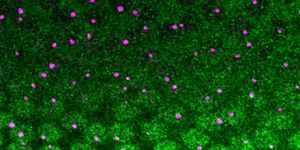Seeing is Believing: The First-ever Image of Quantum Entanglement
Albert Einstein, a hesitant (if at all) believer of quantum mechanics, once dismissed the phenomenon of quantum entanglement as “spooky action at a distance.”
To these days, scientists have more than enough evidence to prove the validity of quantum mechanics. There're numerous applications of the theory in electronics and advanced computing. But what's more exciting, a group of physicists at the University of Glasgow recently reported that they captured the first-ever imagery proof of quantum entanglement.
For Einstein, the physics pioneer who succeeded in describing the intrinsic relationship between space-time and gravity, quantum mechanics represents a giant elephant in his room of relativity physics.
In quantum entanglement, the physical measurements (such as position, momentum, spin, and polarization) of two entangled particles are highly correlated, even though they could be light years apart from each other. With that kind of distance in between, no coordinated actions can be taken simultaneously without ignoring the limitation of light speed. This hypothetic, faster-than-light requisite violates the core idea of Einstein's special theory of relativity.
Thus not surprisingly, along with Boris Podolsky and Nathan Rosen, Einstein published the famous "EPR paper" that showed the arise of paradox in quantum mechanics and claimed the theory as incomplete.
Then enters the challenger. In his groundbreaking paper published in 1964, physicist John Stewart Bell showed under some circumstances, the reasoning of localism and realism, which was used by the trio in the EPR paper, would not be apt for the predictions of quantum mechanics theory.
Later on, his idea was developed into the so-called "Bell inequality" test, the violation of which in quantum tests would confirm a form of strong entanglement. This benchmark test has since been widely adopted in quantum computing and cryptography.
To generate the first-ever image of photon entanglement, the University of Glasgow team devised a smart setup. Comprising three main components, the system splits streams of photons and turns them into entangled twins, passes one twin through four pieces of phase filters and moves the other straight forward, and sends them back down the path and captures their images in the end. The resulted images showed that even though the straight-ahead photons didn't go through the filters, but they underwent the same phase changes like their entangled twins.
When interviewed by the BBC, Paul-Antoine Moreau, the head investigator of the study said: "The image was an elegant demonstration of a fundamental property of nature. It's an exciting result which could be used to advance the emerging field of quantum computing and lead to new types of imaging."
The researchers hope that their discovery could "opens the way to new quantum imaging schemes" that applies the Bell inequality principle. At the same time, it may also hold promise for "quantum information schemes based on spatial variables".
This latest breakthrough discovery was published in the journal Science Advances.
Want to learn more about quantum mechanics? Check out the following video by Veritasium.
Quantum Entanglement & Spooky Action at a Distance (Veritasium)
Source: Science Alert









